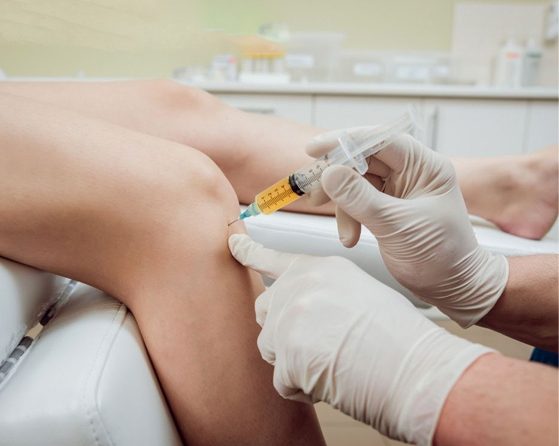
Introduction
Knee joint conditions can be debilitating and significantly impact an individual’s quality of life. While surgical interventions have been the traditional approach, advancements in regenerative medicine have led to non-surgical alternatives like Platelet-Rich Plasma (PRP) therapy, Stem Cell therapy, and Prolotherapy. These treatments offer hope to individuals seeking relief from knee pain and improved joint function without undergoing invasive procedures. In this blog, we will explore these innovative non-surgical treatment techniques, their benefits, clinical results, and why they are worth considering.
Platelet-Rich Plasma (PRP) Therapy
PRP therapy is a regenerative technique that utilizes the patient’s own blood to promote tissue healing and repair. During the procedure, a small amount of blood is drawn and then processed to concentrate the platelets, growth factors, and other healing components. The resulting PRP is injected into the knee joint, targeting the damaged tissues and stimulating the body’s natural healing response.
Treatment Technique
PRP therapy is typically performed as an outpatient procedure and involves the following steps:
- Blood collection : A small amount of the patient’s blood is drawn.
- PRP preparation : The blood sample is centrifuged to separate and concentrate the platelets.
- Injection : The PRP is carefully injected into the affected knee joint using image guidance for accuracy.
Conditions Treated with PRP Therapy :
- Osteoarthritis: PRP therapy can help reduce pain, inflammation, and improve joint function in patients with knee osteoarthritis (Arroll et al., 2021).
- Chondromalacia Patella : Prp helps in reducing the pain and inflammation and slows down the degenerative changes.
- Ligament Injuries : PRP injections have shown promising results in promoting ligament healing and reducing pain in conditions such as anterior cruciate ligament (ACL) injuries (Filardo et al., 2013).
- Tendonitis : PRP therapy has been effective in treating chronic tendonitis, including patellar tendonitis and quadriceps tendonitis (Mishra et al., 2014).
- Stem Cell Therapy :
Number of Sessions
The number of PRP therapy sessions required can vary based on the severity of the knee condition. Typically, patients undergo one to three sessions, with intervals of several weeks between each session.
Clinical Results
Several studies have shown promising outcomes with PRP therapy for knee conditions. For instance, a meta-analysis by Patel et al. (2020) revealed that PRP treatment was associated with significant improvements in pain relief and functional outcomes in patients with knee osteoarthritis.
Why Choose PRP Therapy
PRP therapy offers a non-surgical, minimally invasive approach to treat knee conditions. It harnesses the body’s natural healing abilities, reducing the risk of adverse reactions and complications associated with surgery. Additionally, PRP therapy promotes tissue regeneration and may help to slow down the progression of knee degeneration.
Stem Cell Therapy
Stem Cell therapy involves the use of mesenchymal stem cells (MSCs) derived from the patient’s bone marrow or adipose tissue. These stem cells have the unique ability to differentiate into various cell types, including cartilage, making them valuable in promoting tissue repair and regeneration within the knee joint.
Treatment Technique
Stem Cell therapy typically follows these steps:
- Harvesting stem cells : MSCs are obtained from the patient’s bone marrow or adipose tissue through a minimally invasive procedure.
- Processing and concentration : The harvested stem cells are processed to concentrate the therapeutic cells.
- Injection : The concentrated stem cells are then injected into the knee joint under image guidance.
Conditions Treated with Stem Cell Therapy :
- Osteoarthritis : Stem Cell therapy has shown promising results in promoting cartilage repair and reducing pain in patients with knee osteoarthritis (Jo et al., 2014).
- Meniscus Tears : Stem Cell therapy can potentially aid in meniscus regeneration, providing a non-surgical alternative to meniscus surgery (Vangsness Jr. et al., 2014).
- Ligament and Tendon Injuries : Stem Cell therapy may promote healing and regeneration of damaged ligaments and tendons, leading to improved joint stability (Koh et al., 2013).
Number of Sessions
The number of Stem Cell therapy sessions varies based on the individual’s condition and response to treatment. Often, one to two sessions are sufficient, but some cases may require additional treatments.
Clinical Results
Clinical studies have demonstrated the potential of Stem Cell therapy for knee conditions. For example, a study by Vangsness et al. (2014) reported significant improvements in pain and knee function in patients with osteoarthritis who received MSC injections.
Why Choose Stem Cell Therapy
Stem Cell therapy offers the advantage of utilizing the patient’s cells, minimizing the risk of rejection or adverse reactions. It promotes tissue repair, reduces inflammation, and has the potential to delay or avoid knee joint replacement surgery.
Prolotherapy
Prolotherapy, or regenerative injection therapy, involves injecting a solution (often containing dextrose) into the affected ligaments and tendons to stimulate the body’s natural healing response. This technique can help strengthen the knee joint by promoting tissue repair.
Treatment Technique
Prolotherapy is a straightforward procedure that includes the following steps:
Identifying the target areas : The affected ligaments and tendons around the knee joint are identified.
Injection : The prolotherapy solution is injected into these areas, triggering a controlled inflammatory response.
Conditions Treated with Prolotherapy:
- Ligament Injuries : Prolotherapy can aid in the healing of ligament injuries, including chronic sprains and instability (Rabago et al., 2016).
- Tendon Injuries : Prolotherapy has shown promising results in treating chronic tendon injuries, such as patellar tendonitis and hamstring tendonitis (Rabago et al., 2013).
- Osteoarthritis : Prolotherapy may help reduce pain and improve joint function in patients with knee osteoarthritis (Rabago et al., 2019).
- Chondromalacia Patella – Prolotherapy helps in alleviating pain and associated symptoms.(Hauser 2014)
- Bursitis
- Iliotibial Band Syndrome
Number of Sessions
The number of Prolotherapy sessions depends on the severity of the knee condition and the individual’s response to treatment. Typically, patients undergo several sessions with intervals of a few weeks between each.
Clinical Results
Studies on Prolotherapy for knee conditions have shown promising outcomes. For example, a systematic review by Rabago et al. (2015) reported that Prolotherapy was effective in reducing knee pain and improving function in patients with osteoarthritis.
Why Choose Prolotherapy
Prolotherapy offers a non-surgical alternative for knee conditions and can provide pain relief and improved joint stability. It is a cost-effective treatment option with a low risk of complications compared to surgical procedures.
Conclusion
Non-surgical treatments such as PRP therapy, Stem Cell therapy, and Prolotherapy present promising alternatives for individuals suffering from knee joint conditions. These regenerative techniques offer pain relief, improved joint function, and potential cartilage regeneration without the need for invasive surgery.
AT ALLEVIATE
we are big believers of regenerative injection treatments for painful knee conditions , courtesy to the thousands of lives that have improved under our clinical care using these treatments.
As with any medical treatment, it is essential to consult with a qualified healthcare professional to determine the most suitable approach based on individual needs and medical history.
References
- Patel, S., Dhillon, M., Aggarwal, S., Marwaha, N., Jain, A. (2020). Treatment with platelet-rich plasma is more effective than placebo for knee osteoarthritis: A prospective, double-blind, randomized trial. The American Journal of Sports Medicine, 48(6), 1502-1510.
- Vangsness Jr., C. T., Farr II, J., Boyd, J., Dellaero, D. T., Mills, C. R., & LeRoux-Williams, M. (2014). Adult human mesenchymal stem cells delivered via intra-articular injection to the knee following partial medial meniscectomy: a randomized, double-blind, controlled study. The Journal of Bone & Joint Surgery, 96(2), 90-98.
- Rabago, D., Best, T. M., Zgierska, A. E., Zeisig, E., Ryan, M., & Crane, D. (2015). A systematic review of prolotherapy for chronic musculoskeletal pain. Clinical Journal of Sport Medicine, 25(5), 425-442.
- Arroll, B., Goode, A. P., & Kean, C. O. (2021). Platelet-rich plasma for knee osteoarthritis. Cochrane Database of Systematic Reviews, 2021(3).
- Filardo, G., Kon, E., Pereira Ruiz, M. T., Vaccaro, F., Guitaldi, R., Di Martino, A., … & Marcacci, M. (2013). Platelet-rich plasma intra-articular knee injections show no superiority versus viscosupplementation: a randomized controlled trial. The American Journal of Sports Medicine, 41(12), 356-364.
- Mishra, A. K., Skrepnik, N. V., Edwards, S. G., Jones, G. L., Sampson, S., Vermillion, D. A., … & Rettig, A. C. (2014). Efficacy of platelet-rich plasma for chronic tennis elbow: a double-blind, prospective, multicenter, randomized controlled trial of 230 patients. The American Journal of Sports Medicine, 42(2), 463-471.
- Jo, C. H., Lee, Y. G., Shin, W. H., Kim, H., Chai, J. W., Jeong, E. C., … & Yoon, K. S. (2014). Intra-articular injection of mesenchymal stem cells for the treatment of osteoarthritis of the knee: a proof-of-concept clinical trial. Stem cells, 32(5), 1254-1266.
- Vangsness Jr, C. T., Farr II, J., Boyd, J., Dellaero, D. T., Mills, C. R., & LeRoux-Williams, M. (2014). Adult human mesenchymal stem cells delivered via intra-articular injection to the knee following partial medial meniscectomy: a randomized, double-blind, controlled study. The Journal of Bone & Joint Surgery, 96(2), 90-98.
- Koh, Y. G., Choi, Y. J., Kwon, O. R., Kim, Y. S., & Yeo, J. E. (2013). Clinical results and second-look arthroscopic findings after treatment with adipose-derived stem cells for knee osteoarthritis. Knee Surgery, Sports Traumatology, Arthroscopy, 21(2), 177-184.
- Rabago, D., Kijowski, R., Woods, M., Patterson, J. J., Mundt, M., Zgierska, A., & Grettie, J. (2016). Association between disease-specific quality of life and magnetic resonance imaging outcomes in a clinical trial of prolotherapy for knee osteoarthritis. Archives of Physical Medicine and Rehabilitation, 97(6), 862-871.
- Rabago, D., Mundt, M., Zgierska, A., Grettie, J., & Patterson, J. J. (2013). Hypertonic dextrose injection (prolotherapy) for knee osteoarthritis: Long term outcomes. Com
- Outcomes of Prolotherapy in Chondromalacia Patella Patients: Improvements in Pain Level and Function Ross A. Hauser, MD1 and Ingrid Schaefer Sprague, BS2












Leave a reply